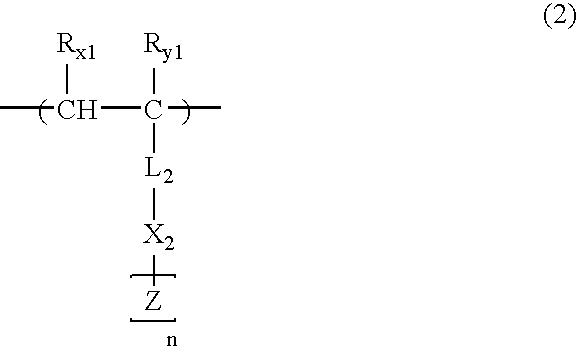Photosensitive resin composition
- Summary
- Abstract
- Description
- Claims
- Application Information
AI Technical Summary
Benefits of technology
Problems solved by technology
Method used
Image
Examples
synthesis examples
(1) Synthesis of Intermediate (M-1):
[0263]
[0264]Fuming sulfuric acid (60 g) and 55.84 g (0.22 moles) of iodine were mixed, to which was then added dropwise 82.03 g (0.2 moles) of 1,3-bis-(2-hydroxyhexafluoroisopropyl) benzene over one hour while heating at 60° C. with stirring. After the dropwise addition, the mixture was stirred for an additional 3 hours, neutralized with an aqueous sodium hydroxide solution, and then extracted with ethyl acetate. The organic layer was dehydrated over 30 g of magnesium sulfate, and the solvent was distilled off. Thereafter, the product was purified by silica gel column chromatography to obtain 50.71 g (yield: 43%) of an intermediate (M-1).
(2) Synthesis of Intermediate (M-2-7):
[0265]
[0266]In 80 g of N,N-dimethylacetamide was dissolved 53.61 g (0.1 moles) of the intermediate (M-1), to which were then added 4.4 g (0.11 moles) of sodium hydroxide and 19.32 g (0.24 moles) of chloromethyl-methyl ether, and the mixture was heated at 100° C. and stirred fo...
example 1
[0281]In 8.5 g of propylene glycol monomethyl ether acetate was dissolved 1.36 g of each of the polymers (1) to (31), and the solution was filtered by a 0.1-μm Teflon-made filter and applied on a potassium fluoride disk by a spin coater, followed by drying under heating at 120° C. for 5 minutes to obtain a film having a film thickness of 0.1 μm. The resulting coating film was measured for absorption by an Acton CAMS-507 spectrometer, from which was then calculated a transmittance at 157 nm. The results obtained are shown in Table 1.
[0282]In 19.6 g of propylene glycol monomethyl ether acetate were dissolved 1.2 g of each of the polymers (1) to (31) and 0.024 g of triphenylsulfonium nonafluorobutanesulfonate, and the solution was filtered by a 0.1-μm Teflon-made filter.
[0283]Each of the photosensitive compositions was applied on a hexamethyl disilazane-processed silicone wafer by a spin coater and evaluated in terms of coating properties. A film thickness was measured in any five poin...
example 2
[0297]Polymers (32) to (40) having varied acid value, molecular weight, degree of distribution and amount of residual non-reacted monomers were obtained under the same synthesis conditions as in the synthesis of the polymer (1), except for using the monomers (II)-1, (II)-3 and (A-19) as the monomers and changing the amount of initiator, the amount of solvent, the heating temperature, the heating time, the amount of hexane during purification, and the number of purification.
[0298]Table 4 shows the composition ratio, acid value, molecular weight, degree of distribution and amount of residual non-reacted monomers of each of the polymers.
[0299]In 8.5 g of propylene glycol monomethyl ether acetate was dissolved 1.36 g of each of the polymers (32) to (40), and the solution was filtered by a 0.1-μm Teflon-made filter and applied on a potassium fluoride disk by a spin coater, followed by drying under heating at 120° C. for 5 minutes to obtain a film having a film thickness of 0.1 μm. The re...
PUM
| Property | Measurement | Unit |
|---|---|---|
| Fraction | aaaaa | aaaaa |
| Fraction | aaaaa | aaaaa |
| Percent by mass | aaaaa | aaaaa |
Abstract
Description
Claims
Application Information
 Login to View More
Login to View More - R&D
- Intellectual Property
- Life Sciences
- Materials
- Tech Scout
- Unparalleled Data Quality
- Higher Quality Content
- 60% Fewer Hallucinations
Browse by: Latest US Patents, China's latest patents, Technical Efficacy Thesaurus, Application Domain, Technology Topic, Popular Technical Reports.
© 2025 PatSnap. All rights reserved.Legal|Privacy policy|Modern Slavery Act Transparency Statement|Sitemap|About US| Contact US: help@patsnap.com



